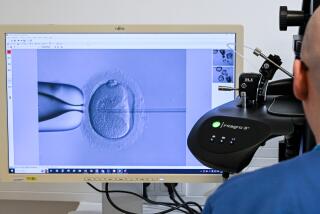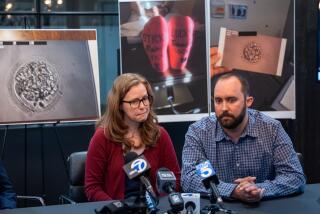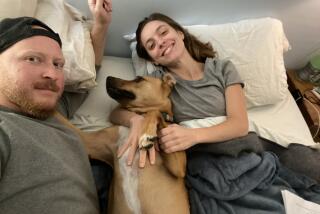Clinic First to Offer Embryo Transplants
- Share via
The nation’s first ovum transfer facility, helping infertile women give birth through a non-surgical method of embryo transplant, has opened at Memorial Medical Center of Long Beach.
Operated jointly by the hospital and Fertility and Genetics Research Inc., the transfer center could eventually anchor a nationwide chain of similar facilities and make common what has heretofore been an experimental medical technique.
“We are now taking these research experiences and converting them to practice,” said Dr. John R. Marshall, medical director of the Los Angeles-based company and former head of obstetrics and gynecology at Harbor-UCLA Medical Center.
Success Rate Analyzed
Since the technique was developed at Harbor-UCLA in 1983, 11 pregnancies have been produced in 109 attempts--a success rate similar to that achieved through so-called “test tube” fertilizations, Marshall said. Of the 11 pregnancies, six babies have been born and two are expected. Three of the pregnancies ended in miscarriage.
Performed without anesthesia in a doctor’s office, the technique--said to be virtually painless--involves fertilizing an egg in a donor through artificial insemination. Five days later, a soft, pliable catheter is used to extract and transplant it into the uterus of a recipient.
Marshall said ovum transfer is ideal “for women who do not have eggs, or for women who are carriers of major genetic abnormalities which they choose not to pass on to their children.” Women otherwise unable to conceive may also use it in place of adoption, he said.
Age Limit Is 44
Transfers will be performed on women up to 44 years of age. And donors must be between 21 and 33, and have had a prior pregnancy to demonstrate that they are fertile. While company officials believe that the technique will appeal mostly to married couples, they have not ruled out also offering transfers to unmarried couples on a case-by-case basis.
The male partner of the recipient will provide semen for the artificial insemination. The donor will be generally matched with the recipient by race, hair color, eye color, height and major blood type so the child can look like its parents although it lacks the mother’s genetic characteristics.
About 200 women are expected to seek ovum transfer during the center’s first year, said James Twerdahl, president of the company. The procedure will cost recipients about $2,000. And the company will compensate donors for expenses such as transportation and baby-sitting services for their own children.
Twerdahl said donors will not profit financially from participating. Although a pool of experienced donors has been working with the Harbor-UCLA physicians for several years, he said he expects news of the center at Memorial to generate more volunteers.
Marshall said most donors are “caring, giving women” who have been “touched by the pain of infertility” as it has affected friends or members of their own families.
“It hurts them to see other couples not being able to have children,” the doctor said.
A second transfer center is planned elsewhere in the Los Angeles area, officials said. And others are planned throughout the nation over the next three to five years.
The principal benefit of linking the centers through the research company, Twerdahl said, “is to be able to have all of the results of the technology analyzed centrally. . . . If we discover there’s a better way of doing something, we’ll be able to communicate that instantly.”
Dr. John E. Buster, who headed the Harbor-UCLA team that developed the transfer technique, is also a company vice president.







